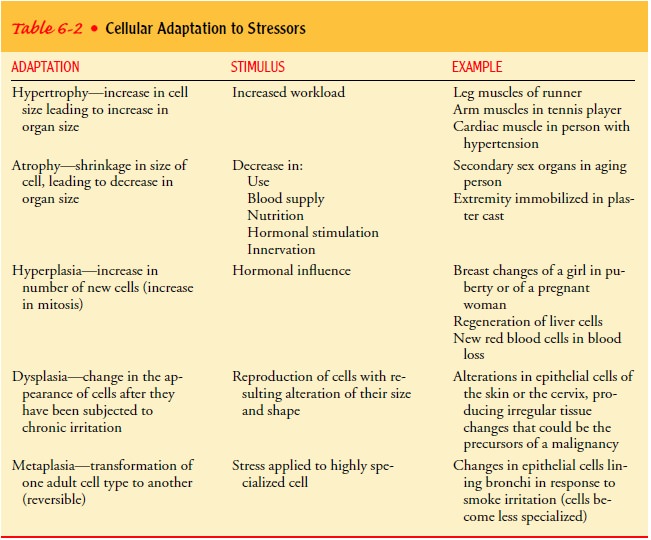Chapter: Medical Surgical Nursing: Homeostasis, Stress, and Adaptation
Cellular Adaptation
CELLULAR
ADAPTATION
Cells are complex units
that dynamically respond to the chang-ing demands and stresses of daily life.
They possess a maintenance function and a specialized function. The maintenance
function refers to the activities that the cell must perform with respect to
itself; specialized functions are those that the cell performs in re-lation to
the tissues and organs of which it is a part. Individual cells may cease to
function without posing a threat to the organ-ism. As the number of dead cells
increases, however, the special-ized functions of the tissues are altered and
the individual’s health is threatened.
Cells can adapt to
environmental stress through structural and functional changes. Some of these
adaptations are hypertrophy, atrophy, hyperplasia, dysplasia, and metaplasia
(Table 6-2).

Hypertrophy and atrophy lead to changes in the size of
cellsand hence the size of the organs they form. Compensatory hy-pertrophy is
the result of an enlarged muscle mass and commonly occurs in skeletal and
cardiac muscle that experiences a pro-longed, increased workload. One example
is the bulging muscles of the athlete who engages in body building.
Atrophy can be the consequence of a disease or of decreaseduse, decreased blood supply, loss of nerve supply, or inadequate nutrition. Disuse of a body part is often associated with the aging process. Cell size and organ size decrease; structures principally affected are the skeletal muscles, the secondary sex organs, the heart, and the brain.
Hyperplasia is an increase in the number of new cells in
anorgan or tissue. As cells multiply and are subjected to increased stimulation,
the tissue mass enlarges. It is a mitotic response (a change occurring with
mitosis), but it is reversible when the stimulus is removed. This distinguishes
it from neoplasia or ma-lignant growth, which continues after the stimulus is
removed. Hyperplasia may be hormonally induced. An example is the in-crease in
the size of the thyroid gland caused by thyroid-stimulating hormone (secreted
from the pituitary gland) when a deficit in thy-roid hormone is detected.
Dysplasia is the change in the appearance of cells
after theyhave been subjected to chronic irritation. Dysplastic cells have a
tendency to become malignant; dysplasia is seen commonly in epithelial cells in
the bronchi of smokers.
Metaplasia is a cell transformation in which a highly special-ized
cell changes to a less specialized cell. This serves a protective function,
because the less specialized cell is more resistant to the stress that
stimulated the change. For example, the ciliated columnar epithelium lining the
bronchi of smokers is replaced by squamous epithelium. The squamous cells can
survive; loss of the cilia and protective mucus, however, can have damaging
consequences.
These adaptations allow
the survival of the organism. They also reflect changes in the normal cell in
response to stress. If the stress is unrelenting, the function of the adapted
cell may suc-cumb, and cell injury will occur.
Related Topics